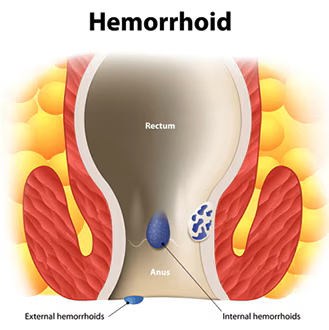There are certain health-related things that can happen when you’re on a plane that you may wish you knew more about but were kind of afraid to ask. I’ve had no qualms about going through some of them in the past:
- Why people fart more on a plane (and how to help prevent it)
- Yes, traveler’s constipation is a thing
- How to stop getting swollen feet on a plane
- All about flying with a cold
There’s one more health-related condition that about 1 in 20 American adults have right now, this second – hemorrhoids. And if you’ve ever tried to fly with an active case of hemorrhoids, especially on a long haul flight, well, you know it’s not fun.
What are hemorrhoids?
Hemorrhoids (sometimes called piles) are swollen and inflamed veins around your anus or in your lower rectum. They can be internal or external.
- Internal hemorrhoids form in the lining of the anus and lower rectum.
- External hemorrhoids form under the skin around the anus.

What Causes Hemorrhoids?
Certain toilet habits (particularly straining when trying to have a bowel movement), constipation, a low-fiber diet, and aging may cause hemorrhoids. Also, about 30-40% of women are diagnosed with hemorrhoids after vaginal childbirth – they may be caused by pushing. All told, roughly 75% of adults will develop hemorrhoids in their lifetime, at one point or another.
Symptoms of Hemorrhoids
Symptoms of hemorrhoids depend on the type of hemorrhoid a person has.
- Internal hemorrhoid symptoms include rectal bleeding.
- External hemorrhoid symptoms include anal itching, irritation and pain, and sometimes bleeding.
When you have external hemorrhoids, it often hurts to stay seated for long periods of time. And if you’re going to be sitting on a plane for hours on end, that’s pretty much going to guarantee you hours of discomfort.
How to Manage Hemorrhoids While Traveling
Not everyone who’s been diagnosed with hemorrhoids has flare-ups all the time; they tend to come and go. But if you’re unlucky enough to have your hemorrhoids bothering you when you have to travel, there are a few things you can do to help make the trip more bearable:
Wipes
Preparation H medicated wipes, Tucks and Cottonelle flushable wet wipes, among others, contain witch hazel and/or aloe, both of which tend to be soothing for itchy, painful hemorrhoids. Regardless of their being “flushable,” DON’T FLUSH THEM – not on a plane, not in a hotel and ESPECIALLY not on a cruise – you run the risk of messing up their pipes. Wrap the wipe in toilet paper and throw it in the garbage.
OTC creams, ointments and suppositories
Like wipes, OTC items made for hemorrhoids, such as Preparation H (cream) and Anusol (suppository), will help soothe the irritation of a hemorrhoid.
Special cushions
One reason hemorrhoids start to be bothersome when you’re sitting is because they’re located right where your body touches the seat. However, if you sit on a special cushion that has a hole where your rectum would be, it makes sitting more bearable because there’s less pressure.
You may want to specifically look for donut style pillows, which leave that hole I was talking about. I’ve heard the ones with memory foam tend to be more comfortable.

Or consider a Roho-style cushion, which allows your weight to be more evenly distributed (Roho cushions are typically used in wheelchairs to prevent pressure sores but in recent years they’ve been touting them for office chairs and such. The former costs MUCH more than the latter.

Dietary Tips to Prevent Flare-Ups
Hemorrhoids can feel worse if you’re constipated, because you have to strain on the toilet. And like we said before, traveler’s constipation is a thing. So, as difficult as it is to eat healthy when you’re traveling, still try the best you can. The most important part of that would include eating high-fiber foods to help soften your stools.
Soft stools = less straining to move your bowels.
Soluble fiber (like oatmeal) makes you stool softer and therefore easier to pass. Insoluble fiber (like vegetables), a.k.a. roughage, helps pushes things through the system. Many high fiber foods have both kinds of fiber. Your goal should be about 25-30 grams of fiber daily, and 1/3 of that should be soluble.
Good examples of high-fiber foods include beans, lentils and nuts, grains, fruits and vegetables.
Foods that have little fiber can cause constipation. So try to avoid white bread, dairy products, meats, and processed foods.
Good luck!
Want to comment on this post? Great! Read this first to help ensure it gets approved.
Want to sponsor a post, write something for Your Mileage May Vary or put ads on our site? Click here for more info.
Like this post? Please share it! We have plenty more just like it and would love it if you decided to hang around and sign up to get emailed notifications of when we post.
Whether you’ve read our articles before or this is the first time you’re stopping by, we’re really glad you’re here and hope you come back to visit again!
This post first appeared on Your Mileage May Vary

2 comments
If you need to carry wipes around, having a roll of baby diaper bags to toss wipes in and tie closed before they go in the garbage is good as well.
Flushable wipes help but taking B-Complex is the key to many people’s hemorrhoid issues. Staying hydrated and getting up every hour or more and not sitting on the toilet for more than a few minutes helps. Hard, thin line and cramps economy seats don’t help, that’s for sure.